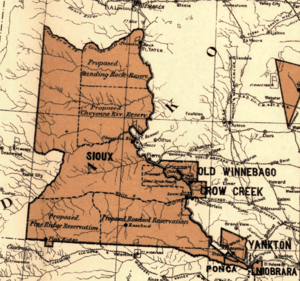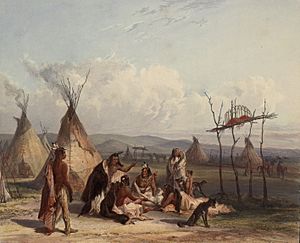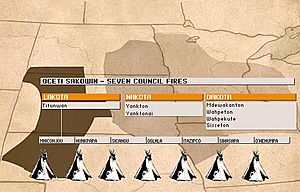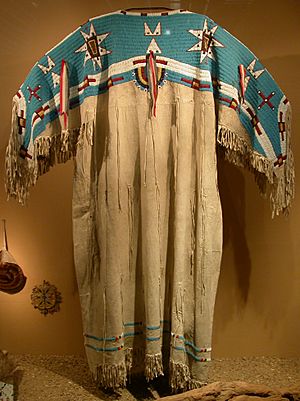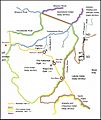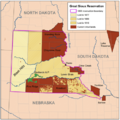Sioux facts for kids
| Očhéthi Šakówiŋ | |
|---|---|
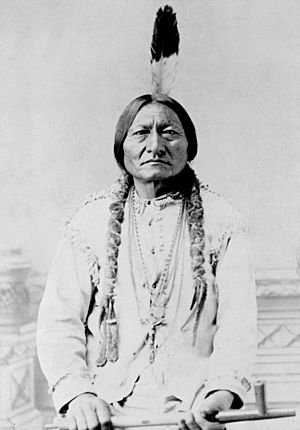
|
|
| Total population | |
| 170,110 | |
| Regions with significant populations | |
| US: (SD, MN, NE, MT, ND, IA, WI, IL, WY) Canada: (MB, SK) |
|
| Languages | |
| Sioux language (Lakota, Western Dakota, Eastern Dakota), Assiniboine, Stoney, English | |
| Religion | |
| Christianity (incl. syncretistic forms), traditional religion | |
| Related ethnic groups | |
| Assiniboine, Dakota, Lakota, Nakoda (Stoney), and other Siouan-speaking peoples |
The Sioux, also known as Očhéthi Šakówiŋ, are groups of Native American tribes and First Nations peoples in North America. The term can refer to any ethnic group within the Great Sioux Nation or to any of the nation's many language dialects. The Sioux comprise three major divisions based on language divisions: the Dakota, Lakota and Nakota.
The Santee Dakota (Isáŋyathi; "Knife") reside in the extreme east of the Dakotas, Minnesota and northern Iowa. The Yankton and Yanktonai Dakota (Iháŋktȟuŋwaŋ and Iháŋktȟuŋwaŋna; "Village-at-the-end" and "Little village-at-the-end"), collectively also referred to by the endonym Wičhíyena, reside in the Minnesota River area. They are considered to be the middle Sioux, and have in the past been erroneously classified as Nakota. The actual Nakota are the Assiniboine and Stoney of Western Canada and Montana. The Lakota, also called Teton (Thítȟuŋwaŋ; possibly "Dwellers on the prairie"), are the westernmost Sioux, known for their hunting and warrior culture.
Today, the Sioux maintain many separate tribal governments scattered across several reservations, communities, and reserves in North Dakota, South Dakota, Nebraska, Minnesota, and Montana in the United States; and Manitoba, southern Saskatchewan, and Alberta in Canada.
Contents
Names
The name "Sioux" was adopted in English by the 1760s from French. It is abbreviated from Nadouessioux, first attested by Jean Nicolet in 1640. The name is sometimes said to be derived from an Ojibwe exonym for the Sioux meaning "little snakes" (compare nadowe "big snakes", used for the Iroquois). The spelling in -x is due to the French plural marker. The Proto-Algonquian form *na·towe·wa, meaning "Northern Iroquoian", has reflexes in several daughter languages that refer to a small rattlesnake (massasauga, Sistrurus). An alternative explanation is derivation from an (Algonquian) exonym na·towe·ssiw (plural na·towe·ssiwak), from a verb *-a·towe· meaning "to speak a foreign language". The current Ojibwe term for the Sioux and related groups is Bwaanag (singular Bwaan), meaning "roasters". Presumably, this refers to the style of cooking the Sioux used in the past.
Some of the tribes have formally or informally adopted traditional names: the Rosebud Sioux Tribe is also known as the Sičháŋǧu Oyáte, and the Oglala often use the name Oglála Lakȟóta Oyáte, rather than the English "Oglala Sioux Tribe" or OST. The alternative English spelling of Ogallala is considered improper.
The historical Sioux referred to the Great Sioux Nation as the Očhéthi Šakówiŋ, meaning "Seven Council Fires". Each fire was a symbol of an oyate (people or nation). The seven nations that comprise the Sioux are: Bdewákaŋthuŋwaŋ (Mdewakanton), Waȟpéthuŋwaŋ (Wahpeton), Waȟpékhute (Wahpekute), Sisíthuŋwaŋ (Sisseton), the Iháŋkthuŋwaŋ (Yankton), Iháŋkthuŋwaŋna (Yanktonai), and the Thítȟuŋwaŋ (Teton or Lakota). The Seven Council Fires would assemble each summer to hold council, renew kinships, decide tribal matters, and participate in the Sun Dance. The seven divisions would select four leaders known as Wičháša Yatápika from among the leaders of each division. Being one of the four leaders was considered the highest honor for a leader; however, the annual gathering meant the majority of tribal administration was cared for by the usual leaders of each division. The last meeting of the Seven Council Fires was in 1850.
Today the Teton, Santee (mixture of the four Dakota tribes) and the Minnesota Dakota, and Yankton/Yanktonai are usually known, respectively, as the Lakota, Eastern Dakota, or Western Dakota. In any of the three main dialects, Lakota or Dakota translate to mean "friend" or "ally", referring to the alliance that once bound the Great Sioux Nation.
History
First contact with Europeans
The Dakota are first recorded to have resided at the source of the Mississippi River and the Great Lakes during the seventeenth century. They were dispersed west in 1659 due to warfare with the Iroquois. By 1700 the Dakota Sioux were living in Wisconsin and Minnesota, at this time they exterminated the Wicosawan, another Siouan people in 1710. A split of branch known as the Lakota had migrated to present-day South Dakota. Late in the 17th century, the Dakota entered into an alliance with French merchants. The French were trying to gain advantage in the struggle for the North American fur trade against the English, who had recently established the Hudson's Bay Company.
Relationship with French traders
The first recorded encounter between the Sioux and the French occurred when Radisson and Groseilliers reached what is now Wisconsin during the winter of 1659–60. Later visiting French traders and missionaries included Claude-Jean Allouez, Daniel Greysolon Duluth, and Pierre-Charles Le Sueur who wintered with Dakota bands in early 1700. In 1736 a group of Sioux killed Jean Baptiste de La Vérendrye and twenty other men on an island in Lake of the Woods. However, trade with the French continued until the French gave up North America in 1763.
Relationship with Pawnees
Author and historian Mark van de Logt wrote: "Although military historians tend to reserve the concept of "total war" for conflicts between modern industrial nations, the term nevertheless most closely approaches the state of affairs between the Pawnees and the Sioux and Cheyennes. Both sides directed their actions not solely against warrior-combatants but against the people as a whole. Noncombatants were legitimate targets. ... It is within this context that the military service of the Pawnee Scouts must be viewed."
The battle of Massacre Canyon on August 5, 1873, was the last major battle between the Pawnee and the Sioux.
Dakota War of 1862
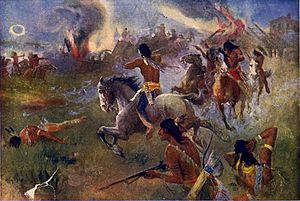
By 1862, shortly after a failed crop the year before and a winter starvation, the federal payment was late. The local traders would not issue any more credit to the Santee and one trader, Andrew Myrick, went so far as to say, "If they're hungry, let them eat grass." On August 17, 1862 the Dakota War began when a few Santee men murdered a white farmer and most of his family. They inspired further attacks on white settlements along the Minnesota River. The Santee attacked the trading post. Later, settlers found Myrick among the dead with his mouth stuffed full of grass.
On November 5, 1862 in Minnesota, in courts-martial, 303 Santee Sioux were found guilty of murder of hundreds of American settlers. They were sentenced to be hanged. No attorneys or witnesses were allowed as a defense for the accused, and many were convicted in less than five minutes of court time with the judge. President Abraham Lincoln commuted the death sentences of 284 of the warriors, while signing off on the death of 38 Santee men on December 26, 1862 in Mankato, Minnesota. It was the largest mass-execution in U.S. history, on US soil.
Afterwards, the US suspended treaty annuities to the Dakota for four years and awarded the money to the white victims and their families. The men remanded by order of President Lincoln were sent to a prison in Iowa, where more than half died.
During and after the revolt, many Santee and their kin fled Minnesota and Eastern Dakota to Canada, or settled in the James River Valley in a short-lived reservation before being forced to move to Crow Creek Reservation on the east bank of the Missouri. A few joined the Yanktonai and moved further west to join with the Lakota bands to continue their struggle against the United States military.
Others were able to remain in Minnesota and the east, in small reservations existing into the 21st century, including Sisseton-Wahpeton, Flandreau, and Devils Lake (Spirit Lake or Fort Totten) Reservations in the Dakotas. Some ended up in Nebraska, where the Santee Sioux Reservation today has a reservation on the south bank of the Missouri.
Those who fled to Canada now have descendants residing on nine small Dakota Reserves, five of which are located in Manitoba (Sioux Valley, Long Plain, Dakota Tipi, Birdtail Creek, and Oak Lake [Pipestone]) and the remaining four (Standing Buffalo, Moose Woods [White Cap], Round Plain [Wahpeton], and Wood Mountain) in Saskatchewan.
Red Cloud's War
Red Cloud's War (also referred to as the Bozeman War) was an armed conflict between the Lakota and the United States Army in the Wyoming Territory and the Montana Territory from 1866 to 1868. The war was fought over control of the Powder River Country in north central Wyoming.
The war is named after Red Cloud, a prominent Sioux chief who led the war against the United States following encroachment into the area by the U.S. military. The war ended with the Treaty of Fort Laramie. The Sioux victory in the war led to their temporarily preserving their control of the Powder River country.
Great Sioux War of 1876
The Great Sioux War of 1876 comprised a series of battles between the Lakota and allied tribes such as the Cheyenne against the United States military. The earliest engagement was the Battle of Powder River, and the final battle was the Wolf Mountain. Included are the Battle of the Rosebud, Battle of the Little Bighorn, Battle of Warbonnet Creek, Battle of Slim Buttes, Battle of Cedar Creek, and the Dull Knife Fight. The Great Sioux War of 1876–77 was also known as the Black Hills War, and was centered on the Lakota tribes of the Sioux, although several natives believe that the primary target of the United States military was the Northern Cheyenne tribe. The series of battles occurred in Montana territory, Dakota territory, and Wyoming territory, and resulted in a victory for the United States military.
Wounded Knee Massacre
The massacre at Wounded Knee Creek was the last major armed conflict between the Lakota and the United States. It was described as a "massacre" by General Nelson A. Miles in a letter to the Commissioner of Indian Affairs.
On December 29, 1890, five hundred troops of the 7th Cavalry Regiment, supported by four Hotchkiss guns (a lightweight artillery piece capable of rapid fire), surrounded an encampment of the Lakota bands of the Miniconjou and Hunkpapa with orders to escort them to the railroad for transport to Omaha, Nebraska.
By the time it was over, 25 troopers and more than 150 Lakota Sioux lay dead, including men, women, and children. It remains unknown which side was responsible for the first shot; some of the soldiers are believed to have been the victims of "friendly fire" because the shooting took place at point-blank range in chaotic conditions. Around 150 Lakota are believed to have fled the chaos, many of whom may have died from hypothermia.
Reservations and reserves
In the late 19th century, railroads wanted to build tracks through Indian lands. The railroad companies hired hunters to exterminate the bison herds, the Plains Indians' primary food supply. The Dakota and Lakota were forced to accept US-defined reservations in exchange for the rest of their lands and farming and ranching of domestic cattle, as opposed to a nomadic, hunting economy. During the first years of the Reservation Era, the Sioux people depended upon annual federal payments guaranteed by treaty for survival.
In Minnesota, the treaties of Traverse des Sioux and Mendota in 1851 left the Dakota with a reservation 20 miles (32 km) wide on each side of the Minnesota River.
Today, half of all enrolled Sioux in the United States live off reservation. Enrolled members in any of the Sioux tribes in the United States are required to have ancestry that is at least 1/4 degree Sioux (the equivalent to one grandparent).
In Canada, the Canadian government recognizes the tribal community as First Nations. The land holdings of these First Nations are called Indian reserves.
Religion
The Sioux tribe, like many North American tribal religions, "were performative, oral, and variable within each community as each generation drew upon its tradition in order to create its own religious forms, derived from experience". "Aboriginal Indian Religions, North of Mexico, were locally produced modes of relationships between communities of associated individuals and their ultimate sources of life... wind, sun, thunderers, animals, corn, etc". Sioux Nation religious beliefs revolve around the Wakan Tanka, which is synonymous with the Great Spirit. Two of their central religious ceremonies are the Sun Dance and the Ghost Dance. The Sioux Nation was one of the few Native American peoples who practiced the Sun Dance and the Ghost Dance.
Linguistics
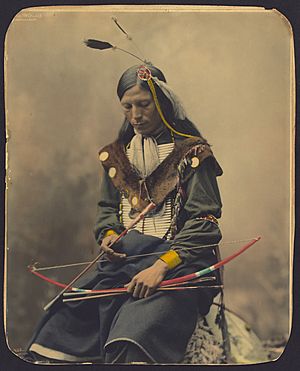
The Sioux comprise three closely related language groups:
- Eastern Dakota (also known as Santee-Sisseton or Dakhóta)
- Santee (Isáŋyáthi: Bdewákhathuŋwaŋ, Waȟpékhute)
- Sisseton (Sisíthuŋwaŋ, Waȟpéthuŋwaŋ)
- Western Dakota (or Yankton-Yanktonai or Dakȟóta)
- Yankton (Iháŋktȟuŋwaŋ)
- Yanktonai (Iháŋktȟuŋwaŋna)
- Lakota (or Lakȟóta, Teton, Teton Sioux)
The earlier linguistic three-way division of the Sioux language identified Lakota, Dakota, and Nakota as dialects of a single language, where Lakota = Teton, Dakota = Santee-Sisseton and Nakota = Yankton-Yanktonai. However, the latest studies show that Yankton-Yanktonai never used the autonym Nakhóta, but pronounced their name roughly the same as the Santee (i.e. Dakȟóta).
These later studies identify Assiniboine and Stoney as two separate languages, with Sioux being the third language. Sioux has three similar dialects: Lakota, Western Dakota (Yankton-Yanktonai) and Eastern Dakota (Santee-Sisseton). Assiniboine and Stoney speakers refer to themselves as Nakhóta or Nakhóda (cf. Nakota).
The term Dakota has also been applied by anthropologists and governmental departments to refer to all Sioux groups, resulting in names such as Teton Dakota, Santee Dakota, etc. This was mainly because of the misrepresented translation of the Ottawa word from which Sioux is derived.
Music
Modern geographic divisions
The Sioux maintain many separate tribal governments scattered across several reservations and communities in North America: in the Dakotas, Minnesota, Nebraska, and Montana in the United States; and in Manitoba, southern Saskatchewan and Alberta in Canada.
The earliest known European record of the Sioux identified them in Minnesota, Iowa, and Wisconsin. After the introduction of the horse in the early 18th century, the Sioux dominated larger areas of land—from present day Central Canada to the Platte River, from Minnesota to the Yellowstone River, including the Powder River country.
Santee (Isáŋyathi or Eastern Dakota)
The Santee migrated north and westward from the Southeastern United States, first into Ohio, then to Minnesota. Some came up from the Santee River and Lake Marion, area of South Carolina. The Santee River was named after them, and some of their ancestors' ancient earthwork mounds have survived along the portion of the dammed-up river that forms Lake Marion. In the past, they were a Woodland people who thrived on hunting, fishing and farming.
Migrations of Ojibwe from the east in the 17th and 18th centuries, with muskets supplied by the French and British, pushed the Dakota further into Minnesota and west and southward. The US gave the name "Dakota Territory" to the northern expanse west of the Mississippi River and up to its headwaters.
Iháŋkthuŋwaŋ-Iháŋkthuŋwaŋna (Yankton-Yanktonai or Western Dakota)
The Iháŋkthuŋwaŋ-Iháŋkthuŋwaŋna, also known by the anglicized spelling Yankton (Iháŋkthuŋwaŋ: "End village") and Yanktonai (Iháŋkthuŋwaŋna: "Little end village") divisions consist of two bands or two of the seven council fires. According to Nasunatanka and Matononpa in 1880, the Yanktonai are divided into two sub-groups known as the Upper Yanktonai and the Lower Yanktonai (Hunkpatina).
They were involved in quarrying pipestone. The Yankton-Yanktonai moved into northern Minnesota. In the 18th century, they were recorded as living in the Mankato region of Minnesota.
Lakota (Teton or Thítȟuŋwaŋ)
The Sioux likely obtained horses sometime during the seventeenth century (although some historians date the arrival of horses in South Dakota to 1720, and credit the Cheyenne with introducing horse culture to the Lakota). The Teton (Lakota) division of the Sioux emerged as a result of this introduction. Dominating the northern Great Plains with their light cavalry, the western Sioux quickly expanded their territory further to the Rocky Mountains (which they call Heska, "white mountains"). The Lakota once subsisted on the bison hunt, and on corn. They acquired corn mostly through trade with the eastern Sioux and their linguistic cousins, the Mandan and Hidatsa along the Missouri River. The name Teton or Thítȟuŋwaŋ is archaic among the people, who prefer to call themselves Lakȟóta.
Ethnic divisions

The Sioux are divided into three ethnic groups, the larger of which are divided into sub-groups, and further branched into bands.
- The Santee live on reservations, reserves, and communities in Minnesota, Nebraska, South Dakota, North Dakota, and Canada. However, after the Dakota war of 1862 many Santee were sent to Crow Creek Indian Reservation and in 1864 some from the Crow Creek Reservation were sent to the Santee Sioux Reservation.
- Most of the Yanktons live on the Yankton Indian Reservation in southeastern South Dakota. Some Yankton live on the Lower Brule Indian Reservation and Crow Creek Indian Reservation. The Yanktonai are divided into Lower Yanktonai, who occupy the Crow Creek Reservation; and Upper Yanktonai, who live in the northern part of Standing Rock Indian Reservation, on the Spirit Lake Tribe in central North Dakota, and in the eastern half of the Fort Peck Indian Reservation in northeastern Montana. In addition, they reside at several Canadian reserves, including Birdtail, Oak Lake, and Moose Woods.
- The Lakota are the westernmost of the three groups, occupying lands in both North and South Dakota.
Today, many Sioux also live outside their reservations.
- Santee division (Eastern Dakota) (Isáŋyathi)
- Mdewakantonwan (Bdewékhaŋthuŋwaŋ "Spirit Lake Village")
- notable persons: Little Crow
- Sisseton (Sisíthuŋwaŋ, perhaps meaning "Fishing Grounds Village")
- Wahpekute (Waȟpékhute, "Leaf Archers")
- notable persons: Inkpaduta
- Wahpetonwan (Waȟpéthuŋwaŋ, "Leaf Village")
- Mdewakantonwan (Bdewékhaŋthuŋwaŋ "Spirit Lake Village")
- Yankton-Yanktonai division (Western Dakota) (Wičhíyena)
- Teton division (Lakota) (Thítȟuŋwaŋ, perhaps meaning "Dwellers on the Prairie"):
- Oglála (perhaps meaning "Those Who Scatter Their Own")
- notable persons: Crazy Horse, Red Cloud, Black Elk, Blue Horse, Iron Tail, Flying Hawk and Billy Mills (Olympian)
- Hunkpapa (Húŋkpapȟa, meaning "Those who Camp by the Door" or "Wanderers")
- notable persons: Sitting Bull
- Sihasapa (Sihásapa, "Blackfoot Sioux," not to be confused with the Algonquian-speaking Piegan Blackfeet)
- Miniconjou (Mnikȟówožu, "Those who Plant by Water")
- notable persons: Lone Horn, Touch the Clouds
- Brulé (French translation of Sičháŋǧu, "Burned Thigh")
- Sans Arc (French translation of Itázipčho, "Those Without Bows")
- Two Kettles (Oóhenupa, "Two Boilings")
- Oglála (perhaps meaning "Those Who Scatter Their Own")
Notable Sioux
Historical
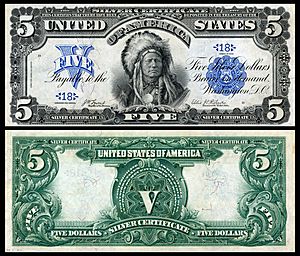
- Šóta (Old Chief Smoke) — an original Oglala Lakota head chief
- Siŋté Glešká (Spotted Tail) — Brulé chief who resisted joining Red Cloud's War
- Thaóyate Dúta (Little Crow/His Red Nation) — Mdewakanton Dakota chief and warrior
- Tȟatȟáŋka Íyotake (Sitting Bull) — Famous Hunkpapa Lakota chief and holy man
- Tȟašúŋke Witkó (Crazy Horse) — Famous Oglala Lakota warrior
- Maȟpíya Ičáȟtagye (Touch the Clouds) – Minneconjou Lakota chief and warrior
- Maȟpíya Lúta (Red Cloud) — Famous Oglala Lakota chief and spokesperson
- Heȟáka Sápa (Black Elk) — Famous Oglala Lakota medicine and holy man
- Ité Omáǧažu (Rain-in-the-Face) — Hunkpapa Lakota war chief
- Tȟáȟča Hušté (Lame Deer) — Mineconju Lakota holy man and spiritual preserver
- Wí Sápa (Black Moon) — Miniconjou Lakota chief
- Matȟó Héȟloǧeča (Hollow Horn Bear) — Sicangu (Brulé) Lakota leader
- Phizí (Gall) — Hunkpapa Lakota war chief
- Ógle Lúta (Red Shirt) — Oglala Lakota warrior and chief
- Inkpáduta (Scarlet Point/Red End) — Wahpekute Dakota war chief
- Waŋbdí Tháŋka (Big Eagle) — Mdewakanton Dakota chief
- Tamaha (One Eye/Standing Moose) — Mdewekanton Dakota chief
- Óta Kté (Luther Standing Bear/Plenty Kill) — Oglala Lakota writer and actor
- Núŋp Kaȟpá (Two Strike) — Sicangu Lakota chief
- Čhetáŋ Sápa (Black Hawk) — Itázipčho Lakota ledger artist
- Tȟatȟóka Íŋyaŋke (Running Antelope) — Hunkpapa Lakota chief
- Matȟó Watȟákpe (John Grass/Charging Bear) — Sihasapa Lakota chief
- Tȟatȟáŋka Ská (White Bull) — Miniconjou Lakota warrior and nephew of Sitting Bull
- Waŋblí Kté (Kill Eagle) — Sihasapa Lakota warrior and leader
- Šúŋkawakȟáŋ Tȟó (Blue Horse) — Oglala chief, warrior, educator and statesman
- Matȟó Wayúhi (Conquering Bear) — Sičháŋǧu Lakota chief
- Čhetáŋ Kiŋyáŋ (Flying Hawk) — Oglala Lakota chief, philosopher, and historian
- Matȟó Wanáȟtake (Kicking Bear) — Oglala born Miniconjou Lakota warrior and chief
- Uŋpȟáŋ Glešká (Spotted Elk/Big Foot) — Miniconjou Lakota chief
- Hé Waŋžíča (Lone Horn) — Miniconjou Lakota chief
- Kȟaŋǧí Yátapi (Crow King/Medicine Bag That Burns) — Hunkpapa Lakota war chief
- Wičháša Tȟáŋkala (Little Big Man/Charging Bear) — Oglala Lakota Warrior
- Šúŋka Khúčiyela (Low Dog) — Oglala Lakota chief and warrior
- Wašíčuŋ Tȟašúŋke (American Horse) ("The Younger") — Oglala Lakota Chief
- Wašíčuŋ Tȟašúŋke (American Horse) ("The Elder") — Oglala Lakota Chief
- Tȟašúŋke Kȟokípȟapi (Young Man Afraid Of His Horses) — Oglala Lakota Chief
- Ištáȟba (Sleepy Eye) — Sisseton Dakota chief
- Ohíyes’a (Charles Eastman) — Author, physician and reformer
- Colonel Gregory "Pappy" Boyington — World War II Fighter Ace and Medal of Honor recipient; 1/4 Sioux
- Charging Thunder (1877–1929), Blackfoot Sioux chief who was part of Buffalo Bill's Wild West Show in 1903, but remained in England when the show returned to America. He married Josephine, an American horse trainer who had just given birth to their first child, Bessie, and together they settled in Darwen, before moving to Gorton. His name became George Edward Williams, after registering with the British immigration authorities to enable him to find work. Williams ended up working at the Belle Vue Zoo as an elephant keeper. He died from pneumonia on July 28, 1929. His interment was at Gorton's cemetery.
- Óta Kté (Luther Standing Bear) — Author, educator, philosopher and actor
- Ziŋtkála-Šá (Gertrude Simmons Bonnin) — Author, educator, musician and political activist
Legacy
A Manitoba Historical Plaque was erected at the Spruce Woods Provincial Park by the province to commemorate Assiniboin (Nakota) First Nation's role in Manitoba's heritage.
Famous Sioux People
Images for kids
-
Chief Black Tail Deer and his family at the 1904 World's Fair
-
Ledger artwork by Lakota artist Black Hawk representing a Heyókȟa, (dreamer of a Wakíŋyaŋ, thunder being), c.1880
-
Chief Red Cloud and other Lakota leaders, c. 1865-1880
-
Yankton Pipestone Quarries as seen by George Catlin in 1836
-
Drawing of the mass hanging of Dakota in Mankato, Minnesota
-
Map showing the major battles of Red Cloud's War, along with major treaty boundaries. During Red Cloud's War, the Sioux defeated the US Army on the same plains on which they previously defeated the Crow
-
Solen Basketball team, Standing Rock Agency (1947)
-
Family members of U.S. Army Master Sgt. Woodrow Wilson Keeble attending his Medal of Honor ceremony
-
Woodrow Keeble, Medal of Honor recipient.
See also
 In Spanish: Siux para niños
In Spanish: Siux para niños



